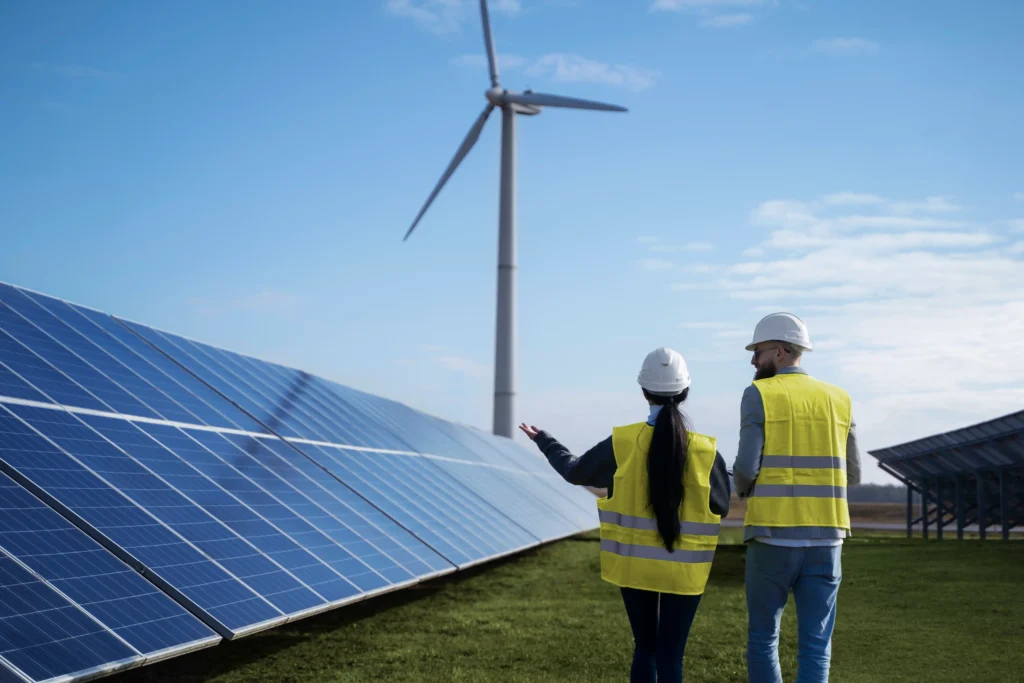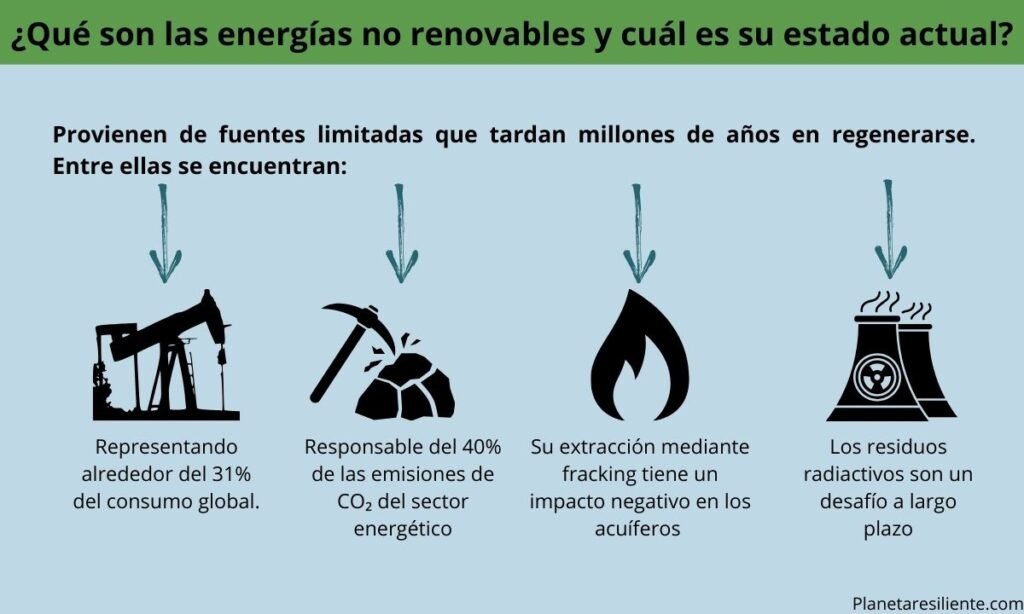What They Don’t Tell You About Non-Renewable Energy
Are we ready for the energy future? Non-renewable energies have been the backbone of industrial and technological development in recent centuries. However, their use brings environmental, economic, and social challenges that affect the entire planet. As fossil fuels are depleted and the impact of climate change becomes more evident, crucial questions arise about the future of energy. In this article, we analyze what is happening with these energy sources, how they affect the world, and which sustainable alternatives are gaining ground.
What are non-renewable energies and what is their current status?
Non-renewable energies come from limited sources that take millions of years to regenerate. They include:
- Oil: The world’s main energy source, accounting for around 31% of global consumption. Its extraction and refining generate high levels of CO₂ emissions, contributing to climate change. Current reserves are estimated to be exhausted in about 50 years at the current consumption rate.
- Coal: One of the most polluting fuels, responsible for 40% of CO₂ emissions from the energy sector. Although its use has decreased in some countries, it remains key in emerging economies such as China and India, where it represents more than 50% of their energy mix.
- Natural gas: Considered a “cleaner” alternative among fossil fuels, emitting 50–60% less CO₂ than coal in electricity generation. However, extraction via fracking has been questioned for its impact on aquifers and seismicity.
- Nuclear energy: Although it does not emit CO₂ during production, radioactive waste poses a long-term challenge. It currently represents 10% of global electricity, with countries like France depending on this source for about 70%. Safety and the high cost of plants remain barriers.

Consumption and resource availability
According to the International Energy Agency (IEA), in 2022 fossil fuels accounted for more than 80% of global energy consumption. Nevertheless, it is estimated that current oil and gas reserves could be exhausted in less than 50 years if the current rate of extraction continues.
| Energy source | Global consumption (%) | Depletion estimate |
|---|---|---|
| Oil | 31% | 2050–2070 |
| Coal | 27% | 100–150 years |
| Natural gas | 24% | 2060–2080 |
| Nuclear energy | 5% | Depends on uranium access |
Despite the world’s high dependence on fossil fuels, uncertainty about their future availability highlights the need to accelerate the transition toward more sustainable energy sources. In addition, factors such as technological advances, the discovery of new deposits, and energy policies can influence these depletion estimates. In this context, renewable energies play a key role in ensuring long-term energy security and mitigating the environmental impact derived from the use of non-renewable sources.
Environmental impact of non-renewable energies
I’ve always wondered what the world would be like if we had never depended on fossil fuels. The reality is that the use of coal, oil, and natural gas has driven industrial development, but it has also left a huge environmental footprint. Air pollution, climate change, and ecosystem degradation are among the most serious consequences. In addition, the extraction and use of these resources generate toxic waste and contribute to global warming through CO₂ emissions. That is why more and more people and governments are seeking sustainable alternatives that allow us to reduce our impact on the planet and move toward a cleaner and more responsible energy model.
Greenhouse gas emissions
I’ve always considered the impact of fossil fuels on the climate to be one of the greatest threats to the planet. Burning coal, oil, and gas not only powers our industries and transportation, it also releases enormous amounts of carbon dioxide (CO₂) and other greenhouse gases. In 2021, according to the Global Carbon Project, we reached an alarming figure: 36.3 gigatonnes of CO₂ emitted into the atmosphere. These emissions trap heat, alter weather patterns, and accelerate phenomena such as heat waves, wildfires, and the melting of the poles. Although there are growing efforts to reduce our dependence on fossil fuels, there is still a long way to go. The transition to clean energy is not just an option, but an urgent necessity if we want to ensure a habitable future for generations to come.
Pollution and ecological damage
I’ve always been struck by how obtaining energy can affect nature so profoundly. Oil spills are among the greatest environmental tragedies, destroying marine ecosystems and affecting thousands of species. Coal extraction not only scars the landscape through deforestation, it also contaminates soils and water bodies. Fracking, for its part, is a technique that has generated controversy, as it can release toxic chemicals that seep into groundwater, affecting communities and ecosystems. And although nuclear energy is a low-emission option, radioactive waste represents a huge challenge, as it must be stored safely for thousands of years. It’s clear we need to rethink our energy sources and move toward more sustainable options.

The transition to renewable energy involves not only a technological shift, but also a major economic and social challenge. Dependence on fossil fuels and the volatility of their prices affect millions of people around the world—from workers to end consumers.
📉 Global Dependence on Fossil Fuels
I’ve always found it striking how oil and gas dominate many countries’ economies. According to the International Energy Agency (IEA), more than 80% of the world’s energy supply still depends on fossil fuels. For nations like Saudi Arabia, Russia, or Venezuela, oil accounts for more than 50% of government revenues. In Latin America, countries such as Mexico and Colombia depend heavily on hydrocarbon exports, making the energy transition a complex challenge.
The transition to renewable energies poses a dilemma: while reducing oil and gas consumption is crucial to tackling climate change, many economies could be affected. According to the International Labour Organization (ILO), transforming the energy sector could eliminate up to 6 million jobs in fossil fuels, although it would also create 24 million new jobs in clean energy by 2030.
💲 Price volatility
I’ve always noticed how oil and gas prices affect the global economy. Over recent decades, these energy sources have experienced major fluctuations. In 2008, the oil price reached $147 per barrel, then fell below $40 in just a few months due to the financial crisis. In 2020, the COVID-19 pandemic triggered a historic drop, even pushing some futures contracts into negative territory. However, in 2022, the conflict between Russia and Ukraine drove oil above $100 per barrel, generating inflation in many countries.
This volatility creates economic uncertainty and affects industries that depend on oil and gas, such as transportation, manufacturing, and electricity generation. It also impacts consumers, raising the cost of living through higher prices for fuels and derived products.
Sustainable alternatives in development
I’ve always found it fascinating how innovation is transforming the way we obtain and use energy. As the climate crisis intensifies, renewable energies and new technologies are advancing at an unprecedented pace, making them more accessible and efficient for everyone.
☀️ Renewables on the rise
The growth of renewable energy has been impressive over the past decade. According to the International Energy Agency (IEA), the costs of solar and wind energy have fallen by more than 80% since 2010, enabling large-scale adoption. This led to record global installed capacity in 2023:
- 🔆 Solar energy: More than 1,000 GW of installed capacity worldwide. In 2022 alone, 192 GW were added, representing nearly 70% of new renewable capacity.
- 💨 Wind energy: Reached 837 GW in 2023, with rapid growth in offshore wind farms, which offer higher efficiency and a lower environmental footprint.
- ⚡ Green hydrogen: Positioning itself as a key alternative for hard-to-decarbonize sectors such as steel and heavy transport. By 2030, green hydrogen production could increase fifty-fold with the expansion of large-scale electrolyzers.
The progress of these technologies not only reduces our dependence on fossil fuels, it also drives new economic and employment opportunities in the energy sector.
🚀 Technological innovation and energy efficiency
I’ve always believed that the energy transition is not only about changing the source, but doing so more efficiently. The key to success lies in new technologies that optimize the generation, storage, and use of energy:
- 🔋 Storage batteries: Lithium-ion battery costs have fallen by 89% since 2010, and more sustainable alternatives are now being developed—such as sodium and graphene batteries—that offer greater capacity and a lower environmental impact.
- 🌐 Smart grids: Power systems are evolving with smart grids that optimize energy distribution and prevent waste, allowing better integration of renewable sources.
- 🛑 Carbon capture and storage (CCS): Although the goal is to reduce emissions, capturing CO₂ from industrial plants and power stations is a key tool. In 2023, operating CCS plants had a capture capacity of 40 million tonnes of CO₂ per year, with projects in development that could double this figure.
These advances are accelerating the shift toward a cleaner, more efficient energy system. Although there are still challenges to overcome, the direction is clear: the future of energy is renewable, smart, and sustainable.
FAQs
What is the environmental impact of non-renewable energies?
Non-renewable energies have a significant environmental impact, since their extraction and use generate greenhouse gas emissions, air and water pollution, and soil degradation. Understanding the environmental impact of non-renewable energies is crucial to effectively addressing today’s climate challenges.
What types of non-renewable energies exist and how do they differ?
Non-renewable energies mainly include fossil fuels (coal, oil, and natural gas) and nuclear energy. Fossil fuels come from organic matter accumulated over millions of years and emit CO₂ when burned. Nuclear energy uses minerals such as uranium, which generate radioactive waste that is difficult to manage.
Why is it considered urgent to leave these resources underground?
Because burning fossil fuels releases huge amounts of CO₂, the main driver of climate change. To avoid dangerous global warming, it is estimated that more than half of known coal, gas, and oil reserves should remain unexploited.
What challenges are involved in replacing them with renewables?
Shifting to renewable energy requires investments in power grids, batteries, and new technologies. It is also necessary to create green jobs to replace those lost in the fossil industry and to ensure a steady supply of clean energy.
Conclusion
The future of non-renewable energies is marked by environmental, economic, and social challenges that cannot be ignored. The growing climate crisis, the volatility of fossil fuel prices, and the need to ensure energy security are forcing countries to rethink their models of energy production and consumption.
As the world moves toward an energy transition, it is crucial to accelerate the development of renewable sources and improve energy efficiency. Solar and wind energy, green hydrogen, and innovations in storage are demonstrating that a sustainable energy system is possible. However, the transformation must be equitable and well planned, ensuring that no community is left behind and that jobs lost in traditional sectors are replaced by new opportunities in the green economy.
The question is no longer whether we must change, but how fast we can do it. With each year of delay, environmental and economic consequences worsen. It is time to invest in technology, public policy, and education to ensure a just and efficient energy transition. Only with a firm global commitment can we secure a sustainable future for the generations to come.

Leave a Reply